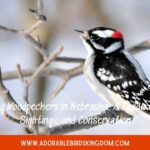I’ve always been fascinated by the rhythmic tap-tap-tap of woodpeckers. It’s a sound synonymous with nature’s harmony. If you’ve ever been in Idaho’s lush forests, you’d know it’s a symphony that’s hard to miss.
Idaho, known for its diverse wildlife, is a haven for various species of woodpeckers. From the iconic Pileated Woodpecker to the elusive Three-toed Woodpecker, Idaho’s landscapes are teeming with these fascinating creatures.
In this blog, we’ll delve into the world of Idaho’s woodpeckers. We’ll explore their unique attributes, behaviors, and the vital roles they play in Idaho’s ecosystems. So, if you’re as intrigued by these feathered carpenters as I am, stick around. It’s going to be a riveting journey.
The Fascinating World of Woodpeckers
These feathered drummers of our wilderness often stir a sense of curiosity within me. My intrigue is piqued not only by their physical beauty or the rhythmic drumming that resonates through Idaho’s forests but by the complex behaviors and ecological roles they play in our environment. It’s vital to appreciate the contribution of these fascinating creatures to Idaho’s diverse ecosystem.
Woodpeckers are specially adapted to life in the trees. With their unique feet configuration – two forward pointing toes and two backwards – they’re able to securely grip the bark of trees. Their long, sticky tongues, up to four times the length of their bill, are ideal for needle-like precision in extracting insects from tree bark. It’s truly a marvel to watch a woodpecker in action.
But woodpeckers do more than just munch on bugs. They’re crucial to the forest, servicing the life-cycle of a variety of organisms. Many birds and mammals make use of woodpecker holes, turning them into homes once the woodpeckers have left. Forest fires, which occur periodically in Idaho, are also controlled to an extent by these pecking wonders. They feed on the bark beetles that proliferate in fire-affected areas, providing a check on their numbers.
Among the species you’ll find in Idaho, the Pileated Woodpecker is a crowd favorite. This large, woodpecker is easily recognized by its distinctive red crest. On the other hand, the Three-toed Woodpecker is quite elusive, often heard rather than seen.
Table 1
|
| Woodpecker Species | Feature |
|---|---|
| Pileated Woodpecker | Prominent red crest |
| Three-toed Woodpecker | Elusive; often heard than seen |
So, as we delve deeper into the world of woodpeckers, let’s keep an open mind to learn from their unique ways. They’re not just part of the backdrop of Idaho’s natural landscape, but active contributors to its well-being. The cacophony of pecks you hear isn’t a disturbance, but music that echoes the harmony of nature—a symphony in which the woodpeckers play a significant part.
Diversity of Woodpecker Species in Idaho
Among Idaho’s rich biodiversity, it’s impossible to overlook the various species of woodpeckers that reside here. Idaho boasts a diverse selection of these fascinating birds – from the large Pileated Woodpecker, with its unmistakable red crest, to the elusive Three-toed Woodpecker, highly prized by bird watchers.
Idaho houses around 11 different species of woodpecker. Each species has its unique characteristics and adaptations, offering a glimpse into the amazing diversity of wildlife found in the state. Here’s a snapshot of some of the notable species you might encounter in Idaho’s forests:
Pileated Woodpecker – A robust and large bird, with striking red crest and a hammering call that echoes through the forests. It prefers older, mature forests, seeking out large trees that offer plenty of wood-boring insects to feed on.
Three-toed Woodpecker – This elusive bird prefers the solitude of remote, forested areas. It has an exceptional ability to find food sources, such as bark beetles, in areas affected by fires or disease.
Lewis’s Woodpecker – Named after explorer Meriwether Lewis, this unique species flies in a slow, soaring pattern rather than a typical woodpecker’s undulating flight. It’s also one of the few woodpecker species to regularly catch insects in flight.
Black-backed Woodpecker – As the name suggests, this woodpecker has a distinct black back and can be found in coniferous forests. These birds have a particular affinity for burnt forests, taking advantage of the lush insect life that thrives post-fire.
One thing that’s abundantly clear is the significant impact each species has on Idaho’s ecosystem. Their foraging activities control forest pests and their tree hollows provide shelter to a myriad of other wildlife. As we delve deeper into their lives and behaviors, we gain a greater appreciation of nature’s delicate balancing act.
Unique Attributes of Idaho’s Woodpeckers
In the natural world, each species is like a puzzle piece. They all have distinct roles that contribute to the whole picture. Among these, Idaho’s woodpeckers present a remarkable example of nature’s adaptability.
Every species exhibits unique characteristics that set them apart. The Pileated Woodpecker, for instance, stands out as the largest woodpecker species in Idaho. Its size alone is impressive, yet what’s even more fascinating is its excavating prowess. This bird is capable of drilling large rectangular holes into trees, revealing a key part of its diet – carpenter ants.
Differently, the Three-toed Woodpecker boasts a distinctive feature right in its name – three toes. Unlike most bird species that have four toes, this woodpecker gets by just fine with three. It sports a unique foraging method, too. Instead of hammering loudly, this species often prefers to quietly flake off the bark of the tree, seeking out their preferred diet of bark beetles.
And then there’s the Black-backed Woodpecker, a species that flourishes in the aftermath of forest fires. It takes advantage of these ecological disturbances, using its sturdy beak to dig out wood-boring beetles hiding in the charred trees.
Lastly, we can’t forget the Lewis’s Woodpecker, named after the famous explorer Meriwether Lewis who first scientifically documented it. Unlike the typical characteristic of woodpeckers pecking away at tree bark, this species displays a unique behavior of catching insects in mid-flight, not unlike a flycatcher.
In a nutshell, these characters highlight Idaho’s robust biodiversification. It becomes as clear as day that the woodpeckers in Idaho are not only diverse in species, but also in the adaptive traits they possess and the roles they play boldly within their ecosystem.
Let’s pivot and take a closer look at the environmental threats these woodpeckers currently face and what measures are being undertaken to ensure their survival.
Behaviors of Woodpeckers in Idaho
In observing Idaho’s woodpeckers, one is struck by their striking behaviors, each uniquely crucial to the state’s ecosystem.
Take the Pileated Woodpecker, for instance. It’s got a flair for construction – a real xcavating powerhouse. Drill a hole into this bird’s day, and you’d see it tirelessly hollowing out large nests in dead trees, also known as snags. By doing so, these ‘architects of the forest’ create habitat spaces for a myriad of forest dwellers, including owls, bats, and other small creatures who find welcomed refuge in these tree cavities.
The Three-toed Woodpecker, on the other claw, is a quiet forager – a feathered ninja, if you will. Despite having one less toe than its avian cousins, this bird cleverly makes up for it by stalking tree trunks silently and hammering its beak hoarsely against the bark. In this stealthy manner, it feeds on wood-boring insects without attracting undue attention.
In the face of forest fires, we find the adaptation champion, the Black-backed Woodpecker. Rather than fleeing, it sees opportunity in the ashes. These birds are equipped to thrive in newly-burned habitats, gorging on the outbreak of wood-boring beetles that follow. It’s a perfect demonstration of nature’s resilience and adaptation.
Speaking of adaptation, Lewis’s Woodpecker is another standout species. What’s interesting about these birds is their insect-catching behavior. Unlike their peers, Lewis’s Woodpeckers forage primarily in flight, snagging insects mid-air or from the ground – chasing their meal more like a flycatcher than a typical woodpecker.
Also included in the category of uniqueness is the conservation efforts made to protect these creatures. Multiple environmental threats loom, and man-made protections step in to buffer the potential fallout. From managing forest fire to curtailing habitat destruction, a lot is being done to ensure these birds continue to thrive in their disrupting environment.
In essence, Idaho’s woodpeckers are not just bird species – they are integral pieces in the larger ecological puzzle. Through their varied behaviors and unique adaptations, they contribute significantly to the cycles of life in Idaho’s forests.
The Vital Roles Woodpeckers Play in Idaho’s Ecosystem
As we explore Idaho’s woodpeckers more deeply, we’re uncovering a multi-layered tale of resilience, ecological balance, and unique contributions to the ecosystem.
The Pileated Woodpecker, often referred to as the “architect of the forest”, illustrates this perfectly. Their expert nest-building skills not only provide shelter for themselves but also create helpful nesting sites for other species. It’s a classic example of nature’s resource sharing and an embodiment of the saying “one man’s house is another man’s hotel”.
Transitioning from the treetops to the bark, we find the Three-toed Woodpecker. It’s not their toes but their foraging techniques that make them an intriguing subject. The Three-toed Woodpecker’s ability to find food where others cannot demonstrates an essential aspect of survival: adaptability. These birds serve as natural pest controllers, curbing harmful insect populations in their habitats.
When wildfires sweep across the forest, it’s the Black-backed Woodpecker that flies towards the blaze. By extracting insects from burned trees, these woodpeckers play a crucial role in rejuvenating fire-destroyed forests. They showcase nature’s resilience and act as a symbol of renewal following destruction.
Hovering in the air, catching insects on the fly, is Lewis’s Woodpecker, another Idaho star. This bird’s aerial acrobatics not only charm observers but also contribute to the overall ecological balance by keeping insect populations in check.
In the face of environmental threats, ensuring the survival of these birds is crucial. That’s why ongoing conservation efforts in Idaho are more important than ever. Actively preserving these birds’ habitats not only safeguards their survival but also maintains the delicate ecological balance in the forests of Idaho.
As we continue to study Idaho’s woodpeckers, it’s clear that their role in sustaining the state’s ecosystem is crucial. While each has its unique contribution, they share a common theme: their actions drive the ecological cycle of life in these densely forested lands. Even without them realizing, their mere existence positively affects the surrounding biodiversity.
Conclusion
So you see, Idaho’s woodpeckers aren’t just fascinating birds to watch, they’re crucial to the state’s forest ecosystems. From the Pileated Woodpecker’s nest-building skills to the Three-toed Woodpecker’s insect control, these birds embody resilience and adaptability. They play a key role in rejuvenating Idaho’s forests post-wildfires and enhancing biodiversity. But they can’t do it alone. They need our help to combat environmental threats. By supporting conservation efforts, we’re not just protecting these remarkable birds, we’re also preserving Idaho’s delicate ecological balance. Remember, every time you spot a woodpecker, you’re witnessing a vital part of Idaho’s ecosystem in action.



